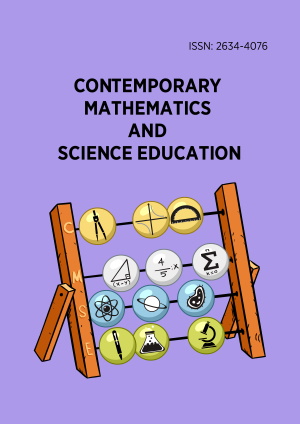Research Article
Proof by play: Teaching the parity principle with math games and puzzles
More Detail
1 Kaye Academic College of Education, Be’er Sheva, ISRAEL* Corresponding Author
Contemporary Mathematics and Science Education, 6(2), July 2025, ep25017, https://doi.org/10.30935/conmaths/17404
Submitted: 28 July 2025, Published: 10 November 2025
OPEN ACCESS 204 Views 396 Downloads
ABSTRACT
Engaging students in formal proof presents a persistent challenge, as learners often default to mechanical step-following rather than conceptual justification. This paper argues that math games and puzzles, rooted in Piaget’s concrete operations, Vygotsky’s (1978) social mediation, and Papert’s (1980) constructionism, provide powerful scaffolds for learning proofs. We synthesize Polya’s (1945) problem-solving heuristics and over two decades of empirical research showing that puzzle-based instruction deepens proof comprehension, fosters transfer to novel contexts, and reduces proof anxiety across age groups. The parity principle serves as a central case study, as students repeatedly practice an invariant reasoning schema through domino-tiling puzzles, handshaking graphs, take-from-ends games, and sliding-tile challenges, which later undergo abstract proof construction. We conclude with practical recommendations for sequencing instruction from manipulatives to symbolic notation, embedding heuristic prompts, promoting collaborative discourse, and leveraging technology. By treating proof as a playful investigation of “what stays the same,” educators can transform proof from a rote ritual into an accessible, engaging process of discovery, equipping learners with durable proof methods for diverse mathematical domains.
CITATION (APA)
Applebaum, M. (2025). Proof by play: Teaching the parity principle with math games and puzzles. Contemporary Mathematics and Science Education, 6(2), ep25017. https://doi.org/10.30935/conmaths/17404
REFERENCES
- Applebaum, M. (2025). Fostering creative and critical thinking through math games: A case study of Bachet’s game. European Journal of Science and Mathematics Education, 13(1), 16–26. https://doi.org/10.30935/scimath/15825
- Applebaum, M., & Freiman, V. (2025). Instilling creativity in pre-service teachers through mathematics puzzles: Case of magic squares. Mathematics Education Research and Practice, 28(3), 263–297.
- Blanton, M., Gardiner, A. M., Ristroph, I., Stephens, A., Knuth, E., & Stroud, R. (2024). Progressions in young learners’ understandings of parity arguments. Mathematical Thinking and Learning, 26(1), 90–121. https://doi.org/10.1080/10986065.2022.2053775
- Csikszentmihalyi, M., & Csikzentmihaly, M. (1990). Flow: The psychology of optimal experience. Harper & Row.
- Engel, A. (1998). Problem‐solving strategies. Springer.
- Fomin, D. V., Genkin, S. A., & Itenberg, I. V. (1996). Mathematical circles: (Russian experience) (vol. 7). American Mathematical Society. https://doi.org/10.1090/mawrld/007
- Ginat, D. (2001). Loop invariants, exploration of regularities, and mathematical games. International Journal of Mathematical Education in Science and Technology, 32(5), 635–651. https://doi.org/10.1080/00207390110038303
- Ginat, D. (2022). Problem solving of mathematical games. In B. Sobota (Ed.), Game theory–From idea to practice. IntechOpen. https://doi.org/10.5772/intechopen.108520
- Hanna, G., de Villiers, M., & International Program Committee. (2008). ICMI Study 19: Proof and proving in mathematics education. ZDM, 40, 329–336. https://doi.org/10.1007/s11858-008-0073-4
- Hannula, M. S. (2012). Exploring new dimensions of mathematics-related affect: Embodied and social theories. Research in Mathematics Education, 14(2), 137–161. https://doi.org/10.1080/14794802.2012.694281
- Harel, I. E., & Papert, S. E. (1991). Constructionism. Ablex Publishing.
- Insorio, A. O., & Librada, A. R. P. (2025). Enhancing students’ academic performance by making the mathematics learning experience meaningful through differentiated instruction. Contemporary Mathematics and Science Education, 6(2), Article ep25008. https://doi.org/10.30935/conmaths/16332
- Movshovitz-Hadar, N. (2011). Bridging between mathematics and education courses: Strategy games as generators of problem solving and proving tasks. In O. Zaslavsky, & P. Sullivan (Eds.), Constructing knowledge for teaching secondary mathematics. Mathematics teacher education vol. 6 (pp. 117–140). Springer. https://doi.org/10.1007/978-0-387-09812-8_8
- Papert, S. (1980). Mindstorms: Children, computers and powerful ideas. Basic Books.
- Piaget, J., & Cook, M. (1952). The origins of intelligence in children. International Universities Press. https://doi.org/10.1037/11494-000
- Pintér, K. (2010). Creating games from mathematical problems. Primus, 21(1), 73–90. https://doi.org/10.1080/10511970902889919
- Polya, G. (1945). How to solve it: A new aspect of mathematical method. Princeton University Press. https://doi.org/10.1515/9781400828678
- Resnick, M. (1997). Turtles, termites, and traffic jams: Explorations in massively parallel microworlds. MIT Press.
- Russo, J., Bragg, L. A., & Russo, T. (2021). How primary teachers use games to support their teaching of mathematics. International Electronic Journal of Elementary Education, 13(4), 407–419. https://doi.org/10.26822/iejee.2021.200
- Schoenfeld, A. H. (1985). Making sense of “out loud” problem-solving protocols. The Journal of Mathematical Behavior, 4(2), 171–191.
- Stiefenhofer, P. (2022). Evaluating pedagogical quality of learning activities using fuzzy evaluation mappings: case of pedagogical games of mathematical proof. Applied Mathematics, 13, 432–452. https://doi.org/10.4236/am.2022.135029
- Stylianides, A. L. (2007). Proof and proving in school mathematics. Journal for Research in Mathematics Education, 38(3), 289–321.
- Stylianides, G. J., & Stylianides, A. J. (2009). Facilitating the transition from empirical arguments to proof. Journal for Research in Mathematics Education, 40(3), 314–352. https://doi.org/10.5951/jresematheduc.40.3.0314
- Sweller, J. (1988). Cognitive load during problem solving: Effects on learning. Cognitive Science, 12(2), 257–285. https://doi.org/10.1016/0364-0213(88)90023-7
- Taasoobshirazi, G., Peifer, J., Duncan, L., Ajuebor, A., & Sneha, S. (2024). An interdisciplinary approach to studying academic success in STEM. Contemporary Mathematics and Science Education, 5(2), Article ep24013. https://doi.org/10.30935/conmaths/14791
- Vygotsky, L. S. (1978). Mind in society: The development of higher psychological processes. Harvard University Press, Cambridge.
- Weber, K. (2001). Student difficulty in constructing proofs: The need for strategic knowledge. Educational Studies in Mathematics, 48, 101–119. https://doi.org/10.1023/A:1015535614355

 The articles published in this journal are licensed under the CC-BY Creative Commons Attribution International License.
The articles published in this journal are licensed under the CC-BY Creative Commons Attribution International License.